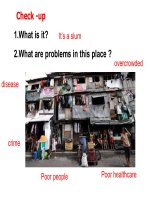Unit 10. Sources of Energy. Lesson 2. A closer look 1
Bạn đang xem bản rút gọn của tài liệu. Xem và tải ngay bản đầy đủ của tài liệu tại đây (881.14 KB, 16 trang )
Trường THCS Đại Đồng Thành
WELCOME TO
CLASS 7A
Giáo sinh: Ngô Thị Lụa
Sources of energy
Renewable
sources
Non -renewable sources
Unit 10: SOURCES OF ENERGY
Lesson 2: A closer book 1
I. Vocabulary
1. Limited >< unlimited
2. Harmful
3. Exhaustible
4. Convenient
5. Available
6. Abundant
7. Enormous
(adj) : hạn chế >< không hạn chế
(adj) : có hại
(adj) : cạn kiệt
(adj) : thuận tiện
(adj) : sẵn có
(adj) : thừa
(adj) : to lớn
* Activity 1:Put the words below into the table to describle the types
of energy: unlimited
limited
harmful
renewable
safe
clean
cheap
non-renewable
exhaustible
dangerous
conveninent
polluting
available
expensive
abundant
SOURCES OF
ENERGY
Wind
Water/ Hydro
Solar energy
Biogas
Nuclear
Coal/oil/natural/gas
Advantage(s)
Disadvantage(s)
SOURCES OF
ENERGY
Advantage(s)
Disadvantage(s)
Wind
Abundant, unlimited
Not available
Water/ Hydro
Clean and safe
Solar
renewable, clean
and safe
Biogas
Nuclear
Coal/oil/natural/gas
renewable, safe,
available, clean
renewable, clean
and safe
abundant
expensive, not available
expensive
Harmful, polluting
expensive, dangerous
Harmful, exhaustible,
polluting
*Activity 2: Compare with partner:
A: I think solar is renewable.
B : Me too. I also think it is clean and safe....
* Activity 3: Look at the pictures and complete these sentences, using the
words in 1.
1.Solar
…… energy is renewable,
safe
Moreover, it is clean and …………
2. Using coal is polluting, and it is ......
non-renewable
…………….
.
Wind power is abundant. It is
3. ………..
clean......and
.. .. safe.
also …….
4. Nuclear energy is renewable and clean.
dangerous
expensive
But it is …..
............and …….
..........
Pronunciation
In three syllable words the mark(‘)
represents the stressed syllable.
• 1. Vớirule
động từ are:
The general
• Trọng âm thường rơi vào âm tiết thứ hai nếu âm tiết cuối chứa một nguyên âm
ngắn và kết thúc nếu âm tiêt không quá một phụ âm.
• Ex: en’counter
•
de’termine
• Trọng âm thường rơi vào âm tiết thứ ba nếu âm tiết này chưa một nguyên âm dài
hoạc một nguyên âm đôi hoặc tận cùng bằng hai phụ âm trở lên
• Ex: en’tertain
Corre’spond
2. Với danh từ và tính từ
Trọng âm rơi vào âm tiết thứ nhất khi âm tiết thứ 2 và 3 là nguyên âm ngắn
Eg:
‘excellent,
‘difficult,
‘dangerous
Trọng âm rơi âm tiết thứ 2 khi âm tiết thứ 2 là nguyên âm dài hoặc nguyên âm đôi .
Âm tiết thứ nhất và thứ 3 là một nguyên âm ngắn .
Các trường hợp khác:
1. Các từ có tận cùng là: -tion, -sion, -ity, -ety, -ic,
-ical, -ous, -ive, -ian, -al thì trọng âm rơi trước
những từ này.
Ex:sug’gestion
geo’graphic ‘critical
• 2. Khi thêm các hậu tố sau thì trọng âm từ chính
không thay đổi: -ous, -ful, -ed, -ly
• -ment, -ness, ...
Ex: ‘Dangerous
‘Limited
*Activity 4:
4. Listen and repeat. Which words are stressed on the first syllable and which ones
are stressed on the second syllable? Put them in the appropriate columns.
dangerous
eastily
abuntdant
enormous
expensive
energy
Ooo
Example: dangerous
limited
plentyful
convenient
oOo
Example: expensive
* Activity 5: Read the following sentences and mark(’) the
stressed syllable in the underlined words. Then listen, check
and repeat.
1. Coal will be replaced by another renewable resource.
2. Wind power is convenient and abundant.
3. Natural gas is limited and it is harmful to the environment.
4. Solar energy is plentiful and it can be replaced easily.
5. Nuclear power is expensive and dangerous.
* Activity 5: Read the following sentences and mark(’) the
stressed syllable in the underlined words. Then listen, check
and repeat.
1. Coal will be replaced by a'nother re'newable resource.
2. Wind power is con'venient and a'bundant.
3. Natural gas is 'limited and it is harmful to the en'vironment.
4. Solar energy is'plentiful and it can be replaced 'easily.
5. Nuclear power is ex'pensive and 'dangerous.
Homework
1. Learn by heart vocabulary introduced in the lesson.
2. Prepare new lesson : Unit 10. A closer look 2.
3. Do exercise A1,2 (page 29), B1,2 (page 30) workbook









